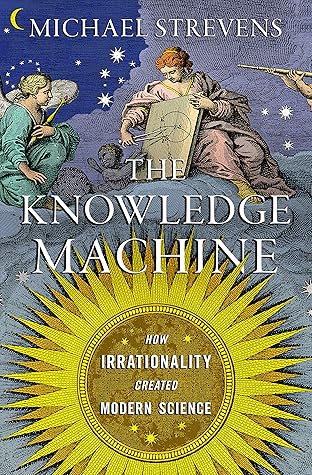More on this book
Community
Kindle Notes & Highlights
“IT IS MORE IMPORTANT to have beauty in one’s equations than to have them fit experiment,” wrote the English theoretical physicist Paul Dirac—the beauty being a sign that the theory was on the right track and that the discrepancy with experiment was likely “due to minor features . . . that will get cleared up with further developments.” Beauty is the beacon; truth is what it marks. Einstein, according to the physicist Eugene Wigner, thought along the same lines: “The only physical theories which we are willing to accept are the beautiful ones.” You needn’t look far to find similar sentiments
...more
Beauty is the beacon; truth is what it marks.
To Aristotle, the iron rule’s proscription of philosophical and theological argument would have seemed arbitrary and indefensible. To a seventeenth-century mind, by contrast, the rule was asking no more of its adherents than the contemporary political and religious settlement: that a dedicated intellectual space be reserved for its exercise, inside which only a strictly constrained set of principles would be allowed to govern the course of reasoning. Partition—civil and spiritual—was the order of the day.
Even after the glorious discoveries carved out by Newton’s narrowly empirical method were published in the Principia in 1687, it was far from inevitable that his strategies would be universally adopted by other natural philosophers. In that case, the Newtonian opus might have stood alone, towering over the subsequent centuries as Aristotle’s philosophy did for so long, admired but unparalleled. That is not what happened: thinkers took up Newton’s project, continuing to deepen its fundamentals and to extend its range—developing theories of heat, light, electricity, and the structure of
...more
THE PROGRAM OF MORALIZING and miseducation that I have sketched in this chapter is not prescribed by the iron rule itself. The rule imposes narrowness on scientific argument and dialogue as it passes through official channels, but as you now know well, it puts no constraints whatsoever on a scientist’s private thoughts and feelings. Indeed, among successful scientists there are extraordinary people who conform to the iron rule in their technical writing but are in no way narrow. They have wandered far outside the boundaries of conventional scientific training and delight in what they find
...more
Among them you might encounter “philosopher-scientists,” such as Albert Einstein and the eighteenth-century physicist, mathematician, and social thinker Émilie du Châtelet (who translated Newton’s Principia into French), or thinkers as familiar with history and literature as they are with the technical apparatus of their craft, such as Stephen Jay Gould and Murray Gell-Mann. They may write books about beauty in nature that celebrate the ideas of Pythagoras and Plato, like the theoretical physicist Frank Wilczek. They may champion the aesthetic and moral importance of natural diversity, like
...more
The clamps are, however, the norm. They are the twentieth and twenty-first centuries’ standard mechanism for turning out new scientists, instilling the iron rule by psychological stratagems rather than by enlightenment or persuasion. What a contrast this makes with the first modern scientists, the inheritors of the Newtonian method in the seventeenth and eighteenth centuries. They followed the iron rule, but they were not its captives. Engaging in public argument, they would perform the role of “the empiricist” in the same way that Newton performed the roles of the mathematical physicist, the
...more
This highlight has been truncated due to consecutive passage length restrictions.
The bitter fate of humanist thought has been to see its glorification of the full, unifying intellectual potential of the human mind eclipsed by the immensely greater contribution to our knowledge of the natural world made by the lean scientific spirit—to comprehend the meagerness of what is found beyond the golden gate of the imagination when measured against the riches brought back through the low and shameful gate of experience.
Even if a certain Newtonian quietude prevails in the great public spaces of science, the back rooms and connecting passages are wide open to untrammeled Cartesian hubbub. Indeed, scientific discovery relies to a not inconsiderable extent on this furtive openness, which has allowed thinkers such as Murray Gell-Mann, D’Arcy Thompson, and Albert Einstein to use their aesthetic and philosophical senses in the search for extraordinary theories. These great scientists were exceptional in more than one way. Not only were they brilliant and imaginative; they also succeeded in evading the deadening
...more
THAT ARCH-METHODIST, Karl Popper, predicated science and indeed civilization on a simple truism: a theory that makes mistaken predictions must itself be wrong. This, the principle of falsification, was the torch that Popper held high to light the path out of the darkness that had haunted his youth, away from social breakdown, mob violence, and mechanized slaughter. A logical rule cannot be improved upon. But the scruples of the people who employ it most certainly can. To that end, Popper believed that it was imperative to fan the critical spirit in science. Inside the white coats, behind the
...more
Might we not strive, nevertheless, for scientific minds that are as unbiased, as unprejudiced, as unprovincial as possible? Certainly, a science of fierce, critical, selfless minds would be an extraordinary thing to behold—like the government of the just or the communion of the holy. But we’ll see it only in our dreams. The knowledge machine is made of human beings, not an angelic host. We need a science that tolerates—or even better, harnesses—human frailty.
THOMAS KUHN’S HANDBOOK for a healthy science makes a rather different set of recommendations. The great Kuhnian insight is that what distinguishes modern science from ancient and medieval science—that is, from “natural philosophy”—is not a superior logical tool kit or advanced technology, but a special form of social organization, the “paradigm.” This all-encompassing methodological framework provides the moral, intellectual, and emotional support that is necessary, as Kuhn wrote, for a scientist to “investigate some part of nature in a detail and depth that would otherwise be unimaginable.”


